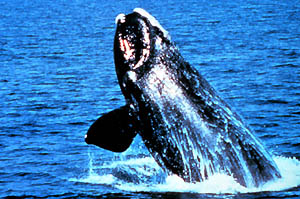 First time in over a century sighting of a northern right whale calf confirmed September 20, 2002
The calf and its mother were discovered by researchers from NOAA's National Marine Fisheries Service (NOAA Fisheries) in the southeastern Bering Sea. The National Oceanic and Atmospheric Administration (NOAA) is an agency of the U.S. Department of Commerce.
"This is cause for celebration," said Jim Balsiger, Regional Administrator for NOAA Fisheries in Alaska. "The North Pacific right whale population is in danger of extinction. A mother and calf embody hope for the whales." NOAA Fisheries researchers from Southwest Fisheries Science Center in La Jolla, California and from the National Marine Mammal Laboratory in Seattle, Washington spotted the calf late on the evening of August 24th. They were on NOAA research vessel McArthur for a dedicated study of right whales in the southeastern Bering Sea. "The weather was heavily overcast when we first made the sighting," said Southwest Fisheries Science Center scientist Lisa Ballance, the research cruise leader. "We immediately launched a small boat with three scientists aboard to get a closer look, and to take photographs and biopsy samples. The rest of us worked from the flying bridge of the main ship, recording video and still photographs. We tracked the pair for over an hour before a rain squall swept over us and shut us down. When the small boat was brought aboard, well after 10 p.m., we compared notes and the conclusion was that this was a female-calf pair. One animal was decidedly smaller than the other, it's blow was smaller in size and more frequent, it swam in a position alongside the flank of the larger whale in a drafting position typical of whale calves in general, and the larger animal seemed intent on keeping itself between the small boat and the calf. It was a very, very exciting conclusion." On September 2nd, the F/V McArthur returned to Kodiak Island, Alaska, and the field project came to an end. Since then, a larger group of scientists has studied proof of what was found. Although the photos were taken in such low light levels that they did not reveal much, the skin sample taken from the larger whale confirmed it was a female. Scientists have identified six individual eastern North Pacific right whales - all male - through skin sampling since 1997. Nine skin samples, including one from the mother of the calf, were taken this year. The 2002 samples are not yet genotyped, but only one is from a female. In July 1996, another NOAA Fisheries research expedition came across right whales in the same area. Pamela Goddard took photos that proved there were at least four adults and - possibly - a calf, but the photo evidence was not clear enough to confirm the calf sighting. Goddard's report inspired a research effort that has had scientists using ships, aircraft and acoustic equipment to search for right whales in this area ever since. Scientists divide the North Pacific right whales into two populations, the eastern and western. The eastern population is more severely depleted than the western. Between 1900 and 1994 there were only 29 reliable sightings of right whales in the eastern North Pacific. Since then scientific expeditions have found a few whales - between about four and 13 individuals - in the eastern North Pacific each year. A minimum of six clearly-identified individual right whales and as many as seven more individuals were seen from the F/V McArthur this summer in the Bering Sea. Right whales were hunted extensively by whalers in the early 1900s because they were easy to catch, and floated after they were killed. Right whale flesh is very rich in oil. Right whales have been protected since 1935. However, illegal Soviet Union whaling in the 1960s pushed the eastern population of North Pacific right whales even closer to the brink of extinction. There was one report of a right whale from the western North Pacific population being caught in a Russian gillnet in the 1980s. Since then, there has been no known human-caused right whale deaths in the North Pacific. Because the Pacific's northern right whale population is small, and because right whales travel so far, not much is known by scientists about their range and habits. It is believed that they summer in the Bering Sea and Gulf of Alaska and may winter as far south as Baja, California and Mexico. They likely calve in winter or spring, after about 12 months gestation. Their primary food is zooplankton - tiny marine creatures such as euphausids and copepods - which they gather by skimming through dense zooplankton patches with their huge mouths agape. To learn more about NOAA's National Marine Fisheries Service (NOAA Fisheries) in Alaska, visit the NOAA Fisheries web site.
Source of News Release:
|
||
